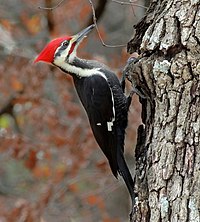
Climate change, woodpeckers, and forests: Current trends and future modeling needs
Sign Up to like & getrecommendations! Published in 2019 at "Ecology and Evolution"
DOI: 10.1002/ece3.4876
Abstract: Abstract The structure and composition of forest ecosystems are expected to shift with climate‐induced changes in precipitation, temperature, fire, carbon mitigation strategies, and biological disturbance. These factors are likely to have biodiversity implications. However, climate‐driven… read more here.
Keywords: forest ecosystem; climate; woodpecker; climate change ... See more keywords

Improved Campephiline detection: An experiment conducted with the Magellanic Woodpecker
Sign Up to like & getrecommendations! Published in 2019 at "Ecology and Evolution"
DOI: 10.1002/ece3.5671
Abstract: Abstract Woodpeckers can be difficult to detect, as they are often cryptic, secretive, occurring in low densities, and wary of humans. Several methods exist to detect woodpeckers (e.g., playback surveys, passive point counts), yet no… read more here.
Keywords: detection; magellanic woodpeckers; magellanic woodpecker; woodpecker ... See more keywords

Tapping the woodpecker tree for evolutionary insight.
Sign Up to like & getrecommendations! Published in 2017 at "Molecular phylogenetics and evolution"
DOI: 10.1016/j.ympev.2017.09.005
Abstract: Molecular phylogenetic studies of woodpeckers (Picidae) have generally focused on relationships within specific clades or have sampled sparsely across the family. We compared DNA sequences of six loci from 203 of the 217 recognized species… read more here.
Keywords: tree; woodpecker tree; tapping woodpecker; woodpecker ... See more keywords

Cameras Show Sciurids Visiting White-Headed Woodpecker Nests Without Depredating Contents
Sign Up to like & getrecommendations! Published in 2017 at "Journal of Fish and Wildlife Management"
DOI: 10.3996/052017-jfwm-039
Abstract: Abstract In western North America, rodents in the family Sciuridae are considered woodpecker nest predators and management to reduce sciurid habitat has been suggested. However, there have been few actual observations of woodpecker nest predation.… read more here.
Keywords: nest predators; headed woodpecker; show sciurids; cameras show ... See more keywords